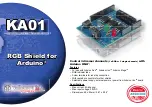
REGUL8OR – User’s Manual
19
1.4
External Interlocks and Status Signals
The system is provided with 6 (six) external interlock inputs that can be easily
configured using the Web Interface (embedded in the power unit) or directly using the
standard power supply commands. A description of the configuration of the external
interlocks using the power supply commands is hereafter described.
The REGUL8OR also presents 6 (six) output status signals that are divided into:
•
2 (two) magnetic relays with the NO, NC and COMMON taps;
•
2 (two) solid state relays with two contacts;
•
2 (two) isolated TTL signals (0-5 V).
All these signals can be connected with other internal signals or status’ (e.g.
module ON, module OFF, all the interlocks and so on) to create automations.
The configurability of the REGUL8OR series allows the users to decide what
interlocks are enabled or not, to set the interlock “trip” level (i.e. low or high), the time
of intervention (i.e. the time that an interlock signal has stay at the “trip” level before
generating a fault condition) and to associate to each one an interlock
name/identification.
This configuration can also be set and read using the Web Interface (provided
with the power module) or using the low-level device configuration commands, which
allows setting the advanced configuration parameters. All interlocks are disabled by
default.
External Interlocks and Status Signals are available on a D-SUB 25-pin Female
type on the rear panel of the REGUL8OR.
Interlock Enable/Disable Mask
The REGUL8OR series external interlocks can be enabled or disabled by
writing to the corresponding Interlock Enable/Disable Mask field of the advanced
configuration parameters. Refer to “Remote Control Manual” for additional details.
Interlock Activation Level Mask
Each external interlock can be chosen to trip at HIGH or LOW logic level. The
dry-contact interlocks are hardware-activated when the input pins and their
corresponding return pin are shorted. The remaining two interlocks are hardware-
activated when there is no voltage between the input pins and their corresponding return
pins. They are hardware-deactivated in case a 24-V voltage source is applied.
















































